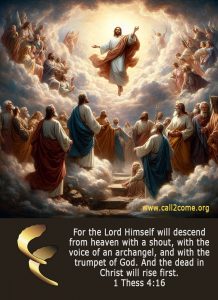
The debate surrounding the timing of the rapture has been both divisive and longstanding. Over the years, it seems that the church has remained polarized on this issue, with proponents of a pre-tribulation rapture, in my experience, often holding a particularly aggressive stance. It’s understandable, really. Faced with the daunting prospect of the tribulations prophesied in scripture, it’s comforting to entertain the notion that God, in His love, would spare His faithful from such persecution and troubles. This perspective, advocating for the removal of the church from the earth before the onset of the great tribulation, finds support from influential leading voices with global reach, impacting millions. However, as I’ve listened to these popular teachers, I’ve often found myself taken aback by the rhetoric that sometimes strays from what the Bible actually teaches—and what it doesn’t. For example, how many times have we heard “the lion shall lay with the lamb”, as an anecdote for the millennial reign? I have, and often when advocating for a pre-tribulation rapture. It’s a picturesque image, evoking a sense of harmony and peace. But here’s the catch: the Bible doesn’t actually say that. It may come as a surprise, but if you examine it for yourself, you’ll find no such verse. The closest resemblance to this imagery is found in the prophecy of Isaiah:
“The wolf also shall dwell with the lamb, The leopard shall lie down with the young goat, The calf and the young lion and the fatling together; And a little child shall lead them. The cow and the bear shall graze; Their young ones shall lie down together; And the lion shall eat straw like the ox.” – Isaiah 11:6-7 (NKJV)
While it’s tempting to presume that the sentiment of the lion lying with the lamb can be inferred from Isaiah’s imagery, it remains just that—a presumption. It’s easy to inadvertently read into the text something that isn’t explicitly stated. But why does this matter? Because when we grapple with weighty matters like the timing of the rapture, it’s imperative we approach them with discernment and clarity, avoiding the pitfalls of rhetoric and popular opinion. Allow me to convey my earnest intention here. I deeply respect and honour the freedom we each possess to form our own beliefs and opinions, including those concerning the rapture. My aim is not to alienate or sow discord within the body of Christ. On the contrary, I am driven by a desire for readiness and a call to embrace our role as the Bride, embodying the spirit of Elijah as we prepare the way for the Lord’s return right up to the Day of His glorious appearing.
The discourse surrounding the rapture has become muddled and laden with conjecture, straying at times from the foundation of scriptural support. With your permission, I propose we wield the Word as a sword, cutting through the haze to examine the Apostle Paul’s perspective. It was Paul, after all, who articulated the concept of the rapture in his letter to the Thessalonians. Let’s delve into his words:
“(15) For this we say to you by the word of the Lord, that we who are alive [and] remain until the coming of the Lord will by no means precede those who are asleep. (16) For the Lord Himself will descend from heaven with a shout, with the voice of an archangel, and with the trumpet of God. And the dead in Christ will rise first. (17) Then we who are alive [and] remain shall be caught up together with them in the clouds to meet the Lord in the air. And thus we shall always be with the Lord. (18) Therefore comfort one another with these words.” – 1Th 4:15-18 NKJV
These verses leave little room for ambiguity. Paul explicitly states that the rapture, referred to as being “caught up,” will coincide with the resurrection. He emphasizes that the dead in Christ will rise first, followed by those who are alive, who will be caught up together with them to meet the Lord in the air. Now whilst there may be much speculation on when the rapture shall be, far less so the resurrection. Since the rapture and resurrection and simultaneous, knowing the timing of the resurrection assures us of when the rapture shall be, and therefore, asking if the rapture occurs before the great tribulation is akin to asking if there is a resurrection before that troublesome time also. At this juncture, some suggest a resurrection occurring before the great tribulation, but this view lacks scriptural support.
Rather than delving into speculative interpretations here, since Paul is the one who introduced the rapture let’s focus on his beliefs about the resurrection rather than our conjecture. Thankfully, scripture does provide a beautiful insight into Paul’s position on the resurrection. In fact, it was this very belief of the resurrection, for which he was arrested and questioned before a hierarchy of rulers. Let’s take a look at what the apostle Paul affirmed when giving his defence before Felix the governor.
“(14) But this I confess to you, that according to the Way, which they call a sect, I worship the God of our fathers, believing everything laid down by the Law and written in the Prophets, (15) having a hope in God, which these men themselves accept, that there will be a resurrection of both the just and the unjust.” – Acts 24:14-15 ESV
In this pivotal moment of defending his beliefs before Felix, Paul staunchly affirms his belief in the resurrection, emphasizing his loyalty to “everything laid down by the Law and written in the Prophets.” By invoking the authority of the Law and the Prophets, Paul aligns himself with the entirety of Old Testament scripture, including its prophecies concerning the resurrection. This underscores the direct connection between the prophetic writings and the timing of the rapture, as they are inherently intertwined. To be clear at this point, I’ll connect the dots here as follows:
To know the timing of the rapture is a matter of knowing the timing of the resurrection as foretold by the “Old Testament” prophets.
In this quest for clarity, let’s turn to the voices of Isaiah and Daniel, both of whom not only spoke of the resurrection but also provided insights into its timing. Remember, this is precisely what Paul passionately advocated for—embracing “everything” the prophets recorded.
“(19) Your dead shall live; [Together with] my dead body they shall arise. Awake and sing, you who dwell in dust; For your dew [is like] the dew of herbs, And the earth shall cast out the dead. (20) Come, my people, enter your chambers, And shut your doors behind you; Hide yourself, as it were, for a little moment, Until the indignation is past. (21) For behold, the LORD comes out of His place To punish the inhabitants of the earth for their iniquity; The earth will also disclose her blood, And will no more cover her slain.” – Isaiah 26:19-21 NKJV
This passage resonates with the promise of resurrection, as the earth is depicted casting out the dead. The imagery of entering chambers and hiding until the Lord’s wrath passes suggests a period of tribulation preceding the ultimate judgment. While there may be some ambiguity regarding the precise sequence of events, the essence of resurrection intertwined with tribulation is evident. The apostle Paul, being well-versed in the Scriptures, would have undoubtedly been familiar with these verses and their implications. Despite potential nuances in the sequence of resurrection and tribulation here, Daniel provides a clearer perspective.
“(1) “At that time Michael shall stand up, The great prince who stands [watch] over the sons of your people; And there shall be a time of trouble, Such as never was since there was a nation, [Even] to that time. And at that time your people shall be delivered, Every one who is found written in the book. (2) And many of those who sleep in the dust of the earth shall awake, Some to everlasting life, Some to shame [and] everlasting contempt. … (7) Then I heard the man clothed in linen, who [was] above the waters of the river, when he held up his right hand and his left hand to heaven, and swore by Him who lives forever, that [it shall be] for a time, times, and half [a time]; and when the power of the holy people has been completely shattered, all these [things] shall be finished.” – Dan 12:1-2, 7 NKJV
Here, the sequence of resurrection and tribulation (known as Jacob’s trouble) is clear. The resurrection of the righteous and unrighteous comes after three and a half years (time, times and half a time). Jesus also taught about this end-time harvest in His parable of the dragnet Matthew 13:47-50, a gathering of both the righteous and unrighteous at the end of the age.
Therefore, if the resurrection comes after the tribulation, then so must the rapture.
In my opinion, this interpretation offers the simplest reading of the biblical narrative, devoid of any need for forced scriptural connections or personal biases, and lets scripture speak for itself.
In conclusion, the Apostle Paul’s perspective on the rapture, intricately woven with his beliefs in the resurrection, offers profound insights for believers navigating the complexities of end-times theology and the unfolding of prophecy in real-time. If we adhere to Paul’s teaching of a rapture then we must also adhere to his passionate belief about the resurrection, which he so vehemently connected with everything the Prophets had written down. By grounding our understanding in Paul’s teachings and aligning them with Old Testament prophecies, we gain clarity on the timing and significance of these eschatological events and a solid foundation upon which we can stand. As we heed Paul’s call to embrace the entirety of scripture, including the Law and the Prophets, we find assurance in the consistent message of God’s redemptive plan unfolding across generations and a blueprint for us to follow.
We are not without a cause. There are essential preparations to be made, not only personally, but also in partnering with Heaven and contending for the nations.
In today’s world, with all the tragedy and sorrow we witness unfold daily, let us also be confident that we have been called for such a time as this. May we approach these matters with humility, discernment, and a steadfast commitment to truth, eagerly anticipating the blessed hope of Christ’s return and our eternal union with Him.






